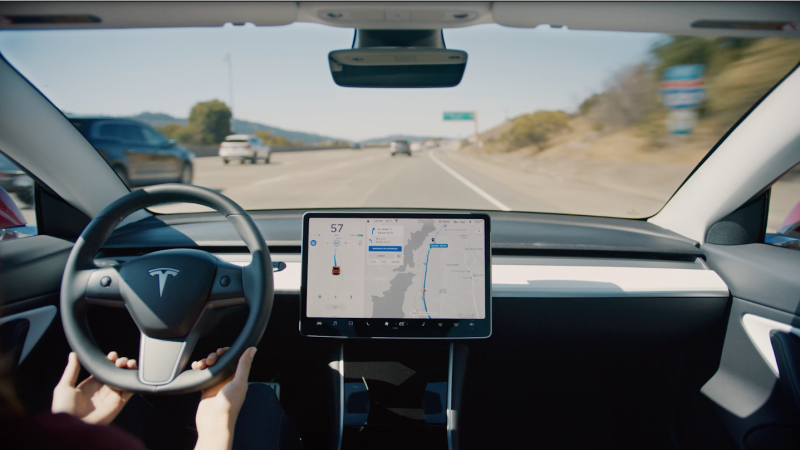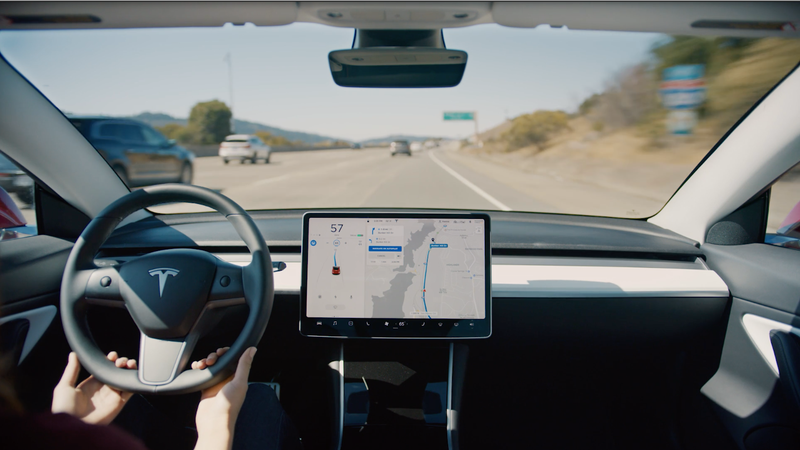Tesla’s late night rollout of a new feature for its semi-autonomous driving system called “Navigate on Autopilot” puzzled me, if not just because of the time it was introduced to the world, but the feature itself: What’s the value in a car that tells you what lane you should be in, when it won’t drive there entirely on its own?
Tesla invited us to New Jersey last week to make its case, and now, I can say, I definitely get it. It’s good. But while Navigate on Autopilot is a helpful step for commuters, it underscores just how long it’ll take until full-autonomy can be achieved.
Yes, Google’s Waymo is carting passengers around today in cars without a driver in Arizona (and soon to be California), and low-speed driverless shuttles are operating today in very limited capacities. But if 2017 was the year of hype around the technology, this past year has demonstrated just how slow and difficult the transition will be for the corporations actually trying to develop it—if it ever catches on at a massive scale at all.
Under Tesla’s approach, reaching the theoretical day of full autonomy will come in incremental steps, and that’s what Navigate on Autopilot is—a tiny step forward.
Advertisement
How It Works
My deputy editor Mike Ballaban made the journey to New Jersey with me, which is nice, because we’re the two in the office that routinely butt heads over whether Autopilot should be developed into a more conservative system—like GM’s Super Cruise, as I would suggest—or, as Ballaban would have it, keep things as-is, with the responsibility on the driver to pay attention, just as it’s always been.
Advertisement
After spending an hour in a Model 3 testing the feature out, I’m convinced it’s an improvement on both fronts.
Take, for example, the notice that pops up when you try to launch Navigate by Autopilot. It states that it doesn’t transform your car into a fully-autonomous system: “Navigate on Autopilot does not make your Model 3 autonomous. Like other Autopilot features, the driver is still responsible for the car at all times.” Very clear and direct, unlike Tesla’s somewhat unclear descriptions of options it marketed and sold in the past.
First, you have to enable the feature in the settings menu, where there’s four settings to pick for speed-based lane changes, including Mild, Average, or Mad Max. There’s an option for “disabled,” which is fine if you just want to use the system’s function that suggests what lane you should be in. On my route, we used Mad Max, but it wasn’t nearly as aggressive as it sounds.
Advertisement
Once you enter directions to a destination, there’ll be a button that appears in the turn-by-turn directions list that says Navigate by Autopilot. Once it’s in use, the car’s collection of eight cameras, 12 ultrasonic sensors, an onboard computer, and radar, works together with Tesla’s mapping data, and the car’s center display will flash a single blue line to follow along with.
One of the biggest changes here is how the car conducts a lane change. With Navigate by Autopilot, the vehicle will automatically enter a recommended lane change offered by the system, so long as the driver confirms it by engaging the turn signal. Tesla tells driver to check if the lane’s clear, and the vehicle itself will determine whether it’s safe to make a lane change. Consumer Reports ran into an issue on this front, saying the system “occasionally recommended that the driver initiate a passing maneuver that would cut off a faster-moving vehicle coming up alongside—a common situation that drivers might encounter when stuck behind a slower vehicle.”
Advertisement
How It Performed
We didn’t run into a situation like that on our drive, but the system performed both gracefully and like a student driver, depending on the situation.
With little traffic around, the car made lane changes with ease, and that’s where the value in the updated system makes sense. Getting from point A to B, on and off a highway, becomes easier, with the system guiding you through the traffic pattern.
Advertisement
But there’s always going to be congestion, and when we hit some busier patches, that’s where Navigate on Autopilot’s limitations became clear. At one point, during a demo ride with a Tesla rep at the wheel, the system told us to make a lane change, but a car was in our blind spot. That caused the car to wavered back and forth a few times, and the rep took back control of the wheel.
In another instance, we were driving about 60 mph on the freeway, as we approached a dump truck trying to merge from the right. The truck tried to merge, but the system told us we needed to be in that lane. The truck was traveling slowly, and, for whatever reason, caused the Model 3’s automatic brakes to engage. It was weird. But Tesla cautions, as always, that the feature is in “beta” mode, and it says the system’s designed to only get better as more data is collected.
Since Tesla says the system will eventually make changes automatically—without driver input—it’s worth underscoring that it’s already being highlighted as a possible issue. (Also, for what it’s worth, both Ballaban and I noticed that Autopilot’s automatic lane-keep function felt much jerkier than we could remember in previous drives in a Tesla.)
Advertisement
The speed-based lane changes are designed to help drivers keep a steady flow on the road. So if your adaptive cruise control speed is dialed into 70 mph, and the car in front of you is set to 65, the system will suggest that you get into the left lane. In the Mild setting, Tesla explains in a blog post, lane change suggestions occur when you’re traveling at a much lower speed, whereas Mad Max kicks in a suggested lane change when you fall a few miles below your set cruise controls peed. Consumer Reports wisely pointed out the system doesn’t suggest that you return to your original lane, setting drivers up to be terrible left-lane hogs, but Tesla told the outlet that future updates will suggest that drivers return to the original lane.
The system’s also designed to automatically take exits, as well, arguably the most impressive addition here, in terms of technological capabilities in a commercially available care today. At these points, the system warns the driver on the center dash that it’s time to resume control of the car.
Advertisement
What’s Next
Ending a trip with Navigate on Autopilot is fairly straightforward, as it’s designed to only function in places set by Tesla’s system. There is one higher-than-normal automated function at this point: if there’s a fork at the exit, the car will automatically move into the correct lane, which honestly moved fast and threw me for a loop at first, but it was a seamless transition.
Once you’re off the highway, it transitions off and the driver’s supposed to resume control of the wheel.
Advertisement
For me, the addition of lane change suggestions should, in theory, make commuting in unfamiliar terrain much easier. When approaching a highway exit, for example, it’s more than welcome. The Model 3, at least on our drive, situated itself in the right lane with more than enough time ahead of our exits, so it definitely makes driving easier.
While I wholeheartedly agree with Ballaban that the system—when used as Tesla describes—works just fine, and that part of the issue is inattentive idiot drivers, Tesla owners have demonstrated to this day that, no matter what sort of warning Tesla throws at them, they’ll continue to push Autopilot beyond its limitations.
That said, the clear warnings about Navigate by Autopilot’s limitations are a welcome addition, and Tesla asserts the system will grow more capable as more cars hit the road, which’ll allow it to collect more data. It’s a step in the right direction for the automaker.
Advertisement
But even as Tesla continues to offer a $3,000 Full Self-Driving Capability option to owners who ask for it, our test drive showed just how far off automakers have to go to make fully-autonomous driving a reality across the U.S.














